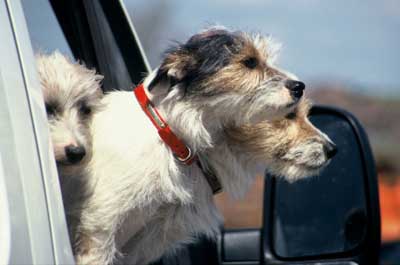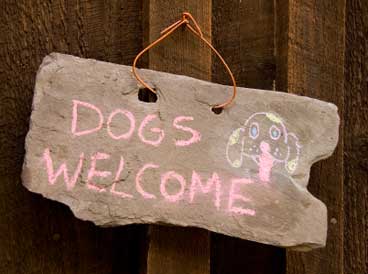Looking forward to a much-needed vacation but not sure about leaving your furry friend behind? We’ve got some advice from the experts on the best ways to travel with your whole family in tow.
Plan Ahead
Not all hotels allow pets inside, so before you leave, research hotels near your stops and make reservations at places you know you can take pets. That way, you know your pet will be welcomed wherever you go. Some hotels even have special VIP accommodations for visitors with pets.
Pet owners should “stay at a place that will respect and welcome them,” says Dan Douglas, the general manager of a Best Western in Allen Park, Michigan.
“We’ve had so many great experiences with pets and pet owners,” Douglas adds. “Problems are rare and far between.”
It’s also a good idea to look into restaurants and activities in the places you’re visiting. Be sure to choose pet-friendly places to go. If not every place on your agenda allows pets, make sure you have the appropriate equipment to leave your pet in the hotel for a couple hours. Notify the front desk and put a “Do Not Disturb” sign on the door so the cleaning service doesn’t come in while you’re gone.
You should also check to make sure there are vets in the area you’re visiting. “Like people, pets on vacation do things they wouldn’t normally do,” says Dr. Meryl Kardon of Back Bay Veterinary Clinic in Boston. Owners should know where to go in case their pet has a medical emergency.
Visit Your Vet
Bring your pet in for a checkup. Make sure he or she is up to date on vaccinations. Some states require you to present rabies vaccination confirmation before you cross the border, so you need to get that from your vet and keep it handy. Many airlines require a certificate of health from within 10 days of the flight. This also applies to a return flight. If you’re going somewhere for more than 10 days, Dr. Sara Rudwell of the Broad Ripple Animal Clinic in Indianapolis, Indiana, recommends that you find a vet in the area you’re staying to do a pre-flight checkup.
You should also talk to your veterinarian about medications or anything else your pet might need to stay comfortable and healthy on the trip. Don’t try any medications or sedatives without your vet’s approval, since they could cause problems or bad reactions, particularly while you’re in the air.
“They could have trouble breathing, or their blood pressure might be dropping,” says Dr. Julie Moodoyan of Southwood Animal Hospital in Tallahassee, Florida. “Particularly on an airplane, it’s hard for pets to be monitored.” In fact, she says many airlines won’t allow a visibly sedated animal onto the plane.
Get Your Pet Acclimated
Make sure your pet is used to traveling before you set out on a long journey. If you’re driving in a car, take smaller trips around your hometown to give your pet practice with being in the car.
If you’re using a kennel, carrier, cage, or crate to transport your pet, either in a car or an airplane, have your pet spend some time in it at home. The kennel will need to be big enough for your pet to sit, stand, and turn around.
Stranger Safety
If you need to transport your pet and don’t want to do it yourself, there are several service options available, depending on your location. However, make sure to do plenty of research on any company you want to hire. Many pet transportation services have been accused of harming or even killing pets in their care due to neglect or abuse. Make sure you have thorough information—some companies have even been known to fake recommendations to get people to hire them.
“On the whole, it’s not the greatest idea,” says Dr. Kardon, though she adds that most pet transporters are very hard and good workers. “Check into the number of pets being transported and the crowding situation.”
It’s always best to check with your vet and others you know and trust who might have experience with pet transportation services to make sure you hire a good company.
Safety First
While you’re traveling, one of your main concerns should be making sure your pet is safe and secure. Always keep your pet in a kennel or strapped into a seatbelt. And even though dogs love sticking their heads out the window or sitting in the back of a pick-up truck, both are dangerous and result in a high death toll for dogs.
Never leave your pet unattended in a car. Not only is there a risk of pet-napping, but pets left in cars can overheat or freeze, depending on the weather. This can also be the case while you’re on the road. If you’re too hot or cold, then your pet probably is, too.
Staying Comfortable
Pets require more than a good kennel to travel comfortably. Be sure to supply your pet with a couple of familiar toys to make the journey more enjoyable. Keep plenty of water handy so your pet doesn’t get dehydrated in the car. It’s always wise to bring your own from home, since your pet might react badly to strange water.
Also, don’t feed your pet too much right before you start out or while the car is in motion. Your pet could get carsick, and that’s not comfortable for him or for you.
Dr. Moodoyan recommends that you bring several familiar toys and blankets for your pet. She says pheromone sprays can also help make your pet feel at ease.
“They utilize the pet’s own pheromones and decease the pet’s anxiety,” she says. She adds that the sprays are odorless to humans. You can find a spray at most pet stores and vet offices.
Pets on a Plane
Today, many airlines allow cats and smaller dogs to travel with you instead of in the cargo hold, which is more comfortable for both of you. Whether or not this is the case, it’s always best to book a nonstop flight to your destination rather than dealing with tricky layovers and plane changes.
Be sure to make reservations in advance so your pet gets a spot on the plane, since some airlines have limits on how many and what kind of pets can travel. “Pets traveling in the cabin require a reservation to ensure no more than seven pets are booked on any single flight,” according to American Airlines.
Make sure that you follow the airline’s regulations about kennel size and vet checkups, particularly since your pet might have trouble adjusting to cabin pressure. Before you leave, “Ask the airline appropriate questions,” says Dr. Rudwell. She advises double-checking on the airline’s pet policies as well as checking the weather to make sure your pet won’t be too hot or cold during the flight.
To make things as easy as possible, walk your pet outside the airport before you take off, and make arrangements to register near the time of departure, so your pet doesn’t spend hours sitting at the airport. In case of an accident while in the air, place absorbent puppy pads or towels in the kennel.
Keeping Track of Your Pet

While you’re traveling, there’s always a chance that your pet could get lost or stolen. Keep him in a collar with your name, address, and phone number.
Many pet institutions are recommending that you have a microchip installed before you leave. These small chips can be read by pet hospitals, vets, and shelters across the country. They make it easy to get information on your lost pet and return him to you quickly.
The microchips, which are about the size of a grain of rice, can be “easily implanted under a pet’s skin,” says Dr. Moodoyan. “Any vet’s office can do it.
“I always recommend a microchip and collar,” she adds.
The procedure is safe and inexpensive, so talk to your vet about it before you leave.
For more information on the tips above, see the links below:
http://hyperboleandahalf.blogspot.com/2010/05/sneaky-hate-spiral.html
http://www.bestwestern.com/tripplanner/travelwithpetstips.asp
http://www.aspca.org/pet-care/pet-care-tips/car-travel-tips.html
http://www.petswelcome.com/
http://www.koa.com/familyzone/camping101/pets10tips.htm
http://www.southwoodanimalhospital.com/
Become a Saturday Evening Post member and enjoy unlimited access. Subscribe now




Comments
Great checklist of things to do so dogs are well cared for, whether with the owner or in someonelse’s care. Mochadoggie’s an important part of our family, so we think of her needs and wants in addition to our own. The same is true of our 3 cats. Thanks for speaking out on their behalf.